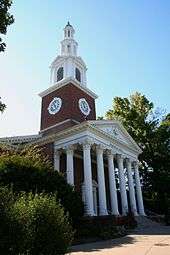Memorial Hall (University of Kentucky)
Memorial Hall (UK building number 0049) located at 610 South Limestone Street is a prominent building on the campus of the University of Kentucky. Completed in 1929 as a memorial to those who died in World War I, it is used for lectures and performances, and also serves as a site for graduation ceremonies of some colleges within the university.[3] It is located on central campus at the end of Funkhouser Drive.


The building is a symbol of the University of Kentucky, often used in promotions and advertising. Its clock tower is known for being featured in the UK logo, between the U and the K. Memorial Hall features cases within its traverse central hall that hold the names of students that served in the World Wars from all the Kentucky counties.
On May 4, 2004 the University of Kentucky Board of Trustees approved the naming of the main auditorium in Memorial Hall in honor of Edward T. (Ned) Breathitt, a former Kentucky governor and former chair of the UK Board of Trustees. Room 102 in Memorial Hall is now known as the Edward T. (Ned) Breathitt Auditorium.
Fresco controversy
The lobby of Memorial Hall features a fresco completed in 1934 by Lexington artist Ann Rice O'Hanlon. The fresco, which is one of the few of its size and scale in the United States, depicts the history of Lexington and central Kentucky from settler times through the 19th century. O'Hanlon received a grant through the Works Progress Administration for the completion of its project, and worked on it for months. The fresco has been the recipient of controversy over its racial depictions. In a 1964 interview, found in the Archives of American Art's New Deal and the Arts project, O'Hanlon addressed her depictions of African Americans in the mural, but did not elaborate on her decision to place images of slaves in the center of the painting. She claimed that the painting was completed before there was much racism in Kentucky and that the state was not as segregated as other southern states (https://www.aaa.si.edu/collections/interviews/oral-history-interview-ann-rice-ohanlon-12570). The fresco in the foyer has been criticized for its romanticized depiction of African American slaves. Students have tried to get the mural removed since at least 2006 and it has been shrouded more than once. In the wake of the George Floyd protests, UK President Eli Capilouto announced on June 5, 2020 that the mural would be removed, becoming one of several memorials and depictions so removed.[4][5][6]
See also
- Buildings at the University of Kentucky
- Cityscape of Lexington, Kentucky
- University of Kentucky
References
- "Interview with Ann Rice O'Hanlon". Oral history interview with Ann Rice O'Hanlon, 1964 July 8.
- Fitch, III, John. "Painted in Stone: The Kentucky Mural". Painted in Stone Documentary Film.
- "A Chronology of UK". University of Kentucky Special Collections & Digital Programs Division. 2 January 2008. Retrieved 2008-01-11.
- Mickle, Jordan (June 5, 2020). "University of Kentucky to remove controversial Memorial Hall mural from campus". WLEX. Retrieved June 8, 2020.
- Childress, Rick (June 5, 2020). "University of Kentucky to remove controversial Memorial Hall mural, president says". Lexington Herald Leader.
- Ladd, Sarah (April 2, 2019). "UK to cover Memorial Hall mural after student sit-in". Kentucky Kernel. Retrieved June 8, 2020.